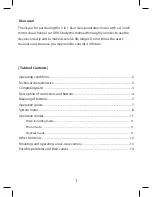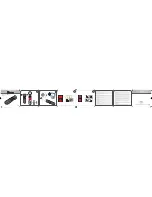
Camera Settings
Exposure
Red Scarlet has possible ISO values of 100 to 6400. The factory default ISO setting is 800. However,
ISO is metadata, and has no bearing on the actual Redcode Raw information recorded by the camera.
The Red Scarlet MX sensor captures images based on a set sensitivity. Unlike traditional video cameras
which have
Gain
to boost sensitivity of the imaging chip (by increasing voltage to the chip), the Red’s
sensor stays at a constant. Any changes to ISO are simply a change in interpretation of the captured data
within the Redcode Raw file. For ideal results with regards to noise, exposing with the Red Scarlet MX
should be based on ISO 800 for outdoor scenes, and ISO 400 for indoor scenes. Pay close attention to
histograms, waveforms, and other tools provided by the camera when exposing. This is, of course, an
ideal.
If circumstances require it, any setting between 100-1000 should yield satisfactory results. Above
1000 will see the introduction of noticeable sensor noise. The higher the ISO value, the more pronounced
the noise.
ALWAYS REMEMBER: Unlike with film stock or traditional gain controls in video
changing ISO does
not
change the actual sensitivity of the camera's sensor.
Ignore the concept of ISO and expose to the right (avoiding clipping) then adjust
the ISO to get an image of visually correct brightness. Then you've got the least
grainy possible image on your RED.
Graeme Nattress, official Red problem solver
Red Exposure Guides (three parts):
http://www.red.com/learn/red-101/exposure-with-red-cameras
ASPECT RATIO/RESOLUTION
Any aspect ratio or resolution combination is acceptable, except for aspect ratios which are
anamorphic
. Anamorphic aspect ratio is squeezed and requires a special anamorphic lens to resolve
properly. Please note that resolutions less than 4k will result in a crop factor to the focal length of the
lens in use (it will appear to zoom in). This is because the camera does not scale the image down, it
simply crops the sensor to match the resolution selected.
Suggested aspect ratio/resolution combinations (with
maximum
time base frame rate on 64GB SSD):
* 4k 1.9:1 | 30 fps (suggested 24fps)
* 4k HD 1.78:1 (16:9) | 30 fps (suggested 24fps)
Reasons for shooting 4K 1.9:1:
•
Gives you slightly wider angle of view
•
Less crop of footage if 2:1 is your final output
Reasons for shooting 4K 16:9:
•
Standard look, no need for cropping or adding black bars for DVD or HDTV
output.
At 4k resolution there is also the option of 4K 2:1, but because this is
cropping
the sensor, this aspect can
be achieved in post. By shooting 4K and cropping in post, you maintain the ability to do slight reframing
if you desire, instead of being stuck with the full image as you shot it (reframing 4k 2:1 in 2:1 aspect is of
course possible, but would require you to zoom into the image).






























